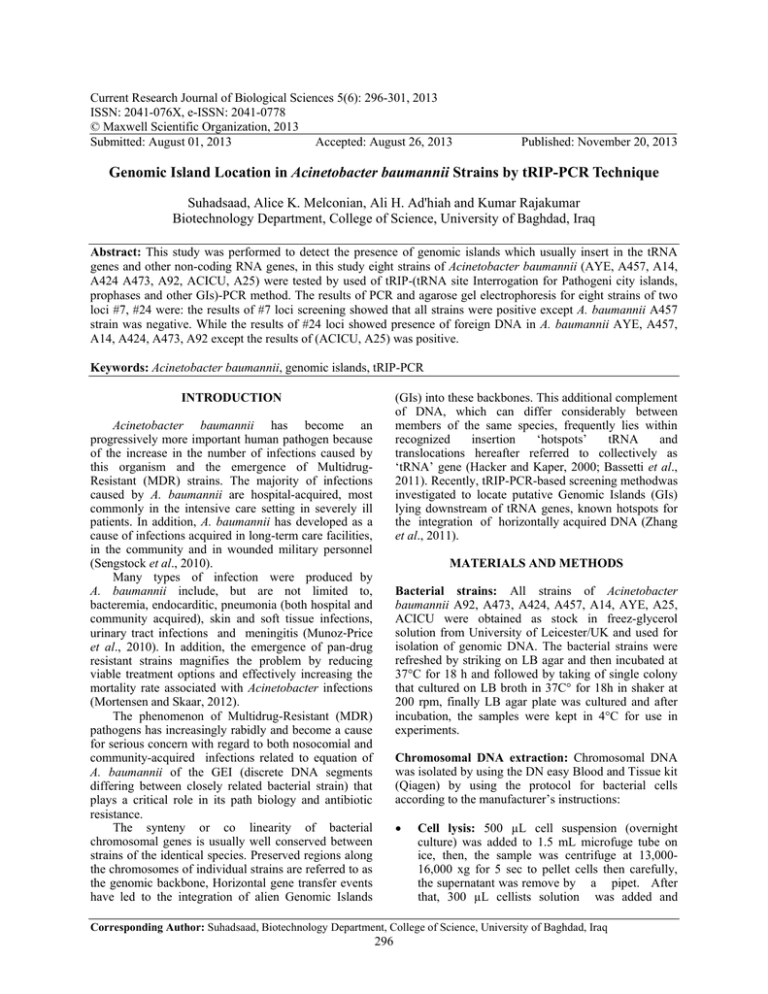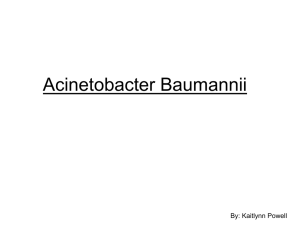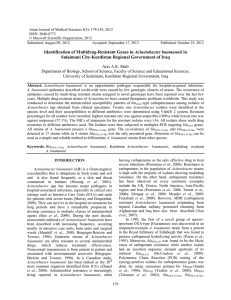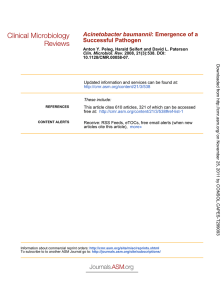Current Research Journal of Biological Sciences 5(6): 296-301, 2013
advertisement

Current Research Journal of Biological Sciences 5(6): 296-301, 2013 ISSN: 2041-076X, e-ISSN: 2041-0778 © Maxwell Scientific Organization, 2013 Submitted: August 01, 2013 Accepted: August 26, 2013 Published: November 20, 2013 Genomic Island Location in Acinetobacter baumannii Strains by tRIP-PCR Technique Suhadsaad, Alice K. Melconian, Ali H. Ad'hiah and Kumar Rajakumar Biotechnology Department, College of Science, University of Baghdad, Iraq Abstract: This study was performed to detect the presence of genomic islands which usually insert in the tRNA genes and other non-coding RNA genes, in this study eight strains of Acinetobacter baumannii (AYE, A457, A14, A424 A473, A92, ACICU, A25) were tested by used of tRIP-(tRNA site Interrogation for Pathogeni city islands, prophases and other GIs)-PCR method. The results of PCR and agarose gel electrophoresis for eight strains of two loci #7, #24 were: the results of #7 loci screening showed that all strains were positive except A. baumannii A457 strain was negative. While the results of #24 loci showed presence of foreign DNA in A. baumannii AYE, A457, A14, A424, A473, A92 except the results of (ACICU, A25) was positive. Keywords: Acinetobacter baumannii, genomic islands, tRIP-PCR (GIs) into these backbones. This additional complement of DNA, which can differ considerably between members of the same species, frequently lies within recognized insertion ‘hotspots’ tRNA and translocations hereafter referred to collectively as ‘tRNA’ gene (Hacker and Kaper, 2000; Bassetti et al., 2011). Recently, tRIP-PCR-based screening methodwas investigated to locate putative Genomic Islands (GIs) lying downstream of tRNA genes, known hotspots for the integration of horizontally acquired DNA (Zhang et al., 2011). INTRODUCTION Acinetobacter baumannii has become an progressively more important human pathogen because of the increase in the number of infections caused by this organism and the emergence of MultidrugResistant (MDR) strains. The majority of infections caused by A. baumannii are hospital-acquired, most commonly in the intensive care setting in severely ill patients. In addition, A. baumannii has developed as a cause of infections acquired in long-term care facilities, in the community and in wounded military personnel (Sengstock et al., 2010). Many types of infection were produced by A. baumannii include, but are not limited to, bacteremia, endocarditic, pneumonia (both hospital and community acquired), skin and soft tissue infections, urinary tract infections and meningitis (Munoz‐Price et al., 2010). In addition, the emergence of pan-drug resistant strains magnifies the problem by reducing viable treatment options and effectively increasing the mortality rate associated with Acinetobacter infections (Mortensen and Skaar, 2012). The phenomenon of Multidrug-Resistant (MDR) pathogens has increasingly rabidly and become a cause for serious concern with regard to both nosocomial and community-acquired infections related to equation of A. baumannii of the GEI (discrete DNA segments differing between closely related bacterial strain) that plays a critical role in its path biology and antibiotic resistance. The synteny or co linearity of bacterial chromosomal genes is usually well conserved between strains of the identical species. Preserved regions along the chromosomes of individual strains are referred to as the genomic backbone, Horizontal gene transfer events have led to the integration of alien Genomic Islands MATERIALS AND METHODS Bacterial strains: All strains of Acinetobacter baumannii A92, A473, A424, A457, A14, AYE, A25, ACICU were obtained as stock in freez-glycerol solution from University of Leicester/UK and used for isolation of genomic DNA. The bacterial strains were refreshed by striking on LB agar and then incubated at 37°C for 18 h and followed by taking of single colony that cultured on LB broth in 37C° for 18h in shaker at 200 rpm, finally LB agar plate was cultured and after incubation, the samples were kept in 4°C for use in experiments. Chromosomal DNA extraction: Chromosomal DNA was isolated by using the DN easy Blood and Tissue kit (Qiagen) by using the protocol for bacterial cells according to the manufacturer’s instructions: • Cell lysis: 500 µL cell suspension (overnight culture) was added to 1.5 mL microfuge tube on ice, then, the sample was centrifuge at 13,00016,000 xg for 5 sec to pellet cells then carefully, the supernatant was remove by a pipet. After that, 300 µL cellists solution was added and Corresponding Author: Suhadsaad, Biotechnology Department, College of Science, University of Baghdad, Iraq 296 Curr. Res. J. Biol. Sci., 5(6): 296-301, 2013 Table 1: tRIP-PCR primer and its results Num Primer name 1 #24-1F 2 #24-1R 3#24-2F 4#24-2R 5#7-1F 6#7-1R 7#7-4F 8#7-2R • • • Primer sequence TATGGCAGCGAATCAACAAA CTGCACCTGTAGCAACCAAA CTGAGCTATTCCCGCAATGT GCGTCGTGCTGATTAAACG ATCGTCATGCCATTGTTCAG TGTCAGAAACTGCGCCTTTA GTTGACCACGTTCTAGATGC TCATTTTCAGGCCTTTCTCG mix by pipet it up and down until cells are suspended. The sample was incubated at 80°C for 5 min to lyse cells. RNase treatment: 1.5 µL RNase Asolution was added to the cell lysate and then the sample was mixed by inverting the tube 25 times and then the sample was incubated at 37°C for 15-60 min. Protein precipitation: the sample was cooled to room temp by placing it on ice for 1 min then 100 µL protein precipitation solution was added to the cell lysate, after that, the sample was mixed by vortex it vigorously at high speed for 20 sec to mix the protein precipitation solution uniformly with the cell lysate, then, the sample was centrifuged at 13000-16000 xg for 3 min lead to the precipitate proteins that lead to form tight pellet. If the protein pellet isn’t tight step 3 should repeated then followed by incubated on ice for 5 min and then repeat step 4. DNA precipitation: The supernatant that contain the DNA (leaving behind the precipitation protein pellet) was poured in to a clean 1.5 mL microfuge tube containing 300 mL 100% isopropanol, then the sample was mixed by inverting gently 50 times. After that the sample was centrifuged at 1300016000 xg for 1 min, the DNA should be visible as small white pellet. Then, the supernatant was discard and then the tube was drained on clean absorbent paper, following that, 300 mL of 70% ethanol was added and then the tube was inverted several times to wash the DNA, after that, the sample centrifuged at 13000-16000 xg for 1 min, then the ethanol pellet was poured and then invert and the tube was drained on clean absorbent paper and allow to air dry 5-10 min. Orientation F R F R F R F R Band size in bp #24-1F+#24-1R 1112 bp #24-2F+#24-2R 94 bp #24-1F+#24-2R 2047 bp #7-1F+#7-1R 59 bp #7-4F+#7-2R 202 bp #7-1F+#7-2R 1848 bp empty sites and/or corresponding islands are found to highly conserved between strains), then the process was completed by used of in silico PCR program that confirm the right binding sites of primers, four sets of primers were designed for two loci #7, #24 of A. baumannii strains. Polymerase Chain Reaction (PCR): For all experiments, PCR reactions were performed in a 20 μL reaction mixture. The components, volumes and concentrations were: 1 μL of primer in a final concentration 10 μM; 10 ng/μL (final concentration) of a plasmid or chromosomal DNA in 1 μL; 0.5 μL of a final concentration of 200 μMdNTPs (deoxyribonucleotide mix, 10 mM each); Expand Taq DNA polymerase 0.1 μL (3.5 U μL-1) and 5 μL of 5×PCR buffer. The reaction mixture was made up to a final volume of 20 μL with nuclease free deionised water. The PCR amplification conditions were: initial template denaturation step of 2 min at 95°C, followed by 33 cycles consisting denaturation step at 95°C for 30 sec, 30 sec of annealing at temperature that depends on the melting temperature of primers, 72°C (for Taq polymerase) for varying amounts of time according to the size of bands used (generally 1min/kb of expected product), followed by final extension step 72C° for 10 min, Finally Hold 15°C forever. RESULTS AND DISCUSSION Many studies have been mentioned that GEIs found at the 63 variable loci were identified in the A. baumannii genomes (Di Nocerai et al., 2011). tRIPPCR was used to detect the genomic islands in tRNAor non-coding RNA genes that consider a hotspot region, in this study tRIP-PCR has been performed of genomic islands that presence in two loci include #7 (that encode for proteins enriched in dipeptide motifs (valine-glycine repeats) hence call Vgr proteins are associated with ligand-binding proteins at the bacterial surfaced and #24 (DNA blocks which potentially encode typical phage products. These regions have all been classified as cryptic prophases (Giannouli et al., 2013). Eight strains of A. bumannii (A92, A473, A424, A457, A14, AYE, A25, ATCC, ACICU) were tested of two loci #7 and #24, After design four sets of primers two for #7 island and the others for #24 loci, then tRIP-PCR was DNA hydration: 50 µL of DNA hydration solution was added to the sample, and then DNA was rehydrated by incubating sample for 1hr at 65°C and or overnight at room temp, Finally, DNA was stored at 4°C, long term storage at -20° C. Primer design: tRIP-PCR primers of this technique were designed according Mobilize Finder tool (Table 1), Extract Flank method that was used to extract and align 2 kb of conserved flanking sequence upstream and downstream of genomic islandloci (because it depends on that DNA sequences immediately flanking the 297 Curr. Res. J. Biol. Sci., 5(6): 296-301, 2013 #7-1F+1R 59bp #7-1F+1R(59 bp)-ACICU #7-4F+2R 202bp 298 Curr. Res. J. Biol. Sci., 5(6): 296-301, 2013 #7-4F+2R (202bp) ACICU #7-1F+2R 1848 #7-1F+2R (1848 bp) ACICU 299 Curr. Res. J. Biol. Sci., 5(6): 296-301, 2013 #24-1F+1R 1112bp #24-2F+2R 94bp #24-1F+2R-2047bp 300 Curr. Res. J. Biol. Sci., 5(6): 296-301, 2013 #24-1F+2R 2047bp Fig. 1: The results of tRIP-PCR of eight strains of A. baumannii on 1% agarose, at 100 V for 1 hr Table 2: The results of tRIP-PCR Primers pairs A92 A473 A424 #7-1F+1R + + + #7-4F+2R + + + #7-1F+2R + + + #24-1F+1R + + + #24-2F+2R + + + #24-1F+2R NEG NEG NEG #7-AYE positive control, #24-ACICU positive control A457 + + NEG + + NEG A14 + + + + + NEG AYE + + + + + NEG A25 + + + + + + ACICU + + + + + + Size in BP 59 bp 202 bp 1848 bp 1112 bp 94 bp 2047 bp Mortensen, B.L. and E.P. Skaar, 2012. Host-microbe interactions that shape the pathogenesis of acinetobacter baumannii infection. Cell. Microbiol., 14(9): 1336-1344. Munoz‐Price, L.S., T. Zembower, S. Penugonda, P. Schreckenberger, M.A. Lavin, S. Welbel, D. Vais, M. Baig, S. Mohapatra, J.P. Quinn and R.A. Weinstein, 2010. Clinical outcomes of carbapenem‐resistant acinetobacter baumannii bloodstream infections: Study of a 2‐State monoclonal outbreak. Infect. Cont. Hosp. Ep., 31(10): 1057-1062. Pilhofer, M., K. Rappl, C. Eckl, A.P. Bauer, W. Ludwig and K. Schleifer, 2008. Characterization and evolution of cell division and cell wall synthesis genes in the bacterial phyla verrucomicrobia, lentisphaerae, chlamydiae and planctomycetes and phylogenetic comparison with rRNA genes. J. Bacteriol., 190(9): 3192. Sengstock, D.M., R. Thyagarajan, J. Apalara, A. Mira, T. Chopra and K.S. Kaye, 2010. Multidrugresistant acinetobacter baumannii: An emerging pathogen among older adults in community hospitals and nursing homes. Clin. Infect. Dis., 50(12): 1611. Zhang, J., J.J. van Aartsen, X. Jiang, Y. Shao, C. Tai, X. He, Z. Tan, Z. Deng, S. Jia, K. Rajakumar and H. Ou, 2011. Expansion of the known Klebsiella pneumoniae species gene pool by characterization of novel alien DNA islands integrated into tmRNA gene sites. J. Microbiol. Meth., 84(2): 283-289. performed and the results of PCR and agarosegel electrophoresis were (Fig. 1). The results of tRIP-PCR method for eight strains (A92, ACICU, A25, A457, AYE, A14, A424A473) of #7 loci were (Table 2): all strains give positive results (band) except A457 strain that was negative that confirm the presence of foreign DNA, while the results of #24 loci were: the presence of foreign DNA in (AYE, A457, A14, A424A473, A92) that lead for negative results, while other strains was positive (ACICU, A25) (Pilhofer et al., 2008; Di Nocera et al., 2011). REFERENCES Bassetti, M., F. Ginocchio and M. Mikulska, 2011. New treatment options against gram-negative organisms. Crit. Care, 15(2): 215. Di Nocera, P., F. Rocco, M. Giannouli, M. Triassi and R. Zarrilli, 2011. Genome organization of epidemic acinetobacter baumannii strains. BMC Microbiol., 11(1): 224. Giannouli, M., L. Antunes, V. Marchetti, M. Triassi, P. Visca and R. Zarrilli, 2013. Virulence-related traits of epidemic acinetobacter baumannii strains belonging to the international clonal lineages I-III and to the emerging genotypes ST25 and ST78. BMC Infect. Dis., 13(1): 282. Hacker, J. and J.B. Kaper, 2000. Pathogen city islands and the evolution of microbes. Annu. Rev. Microbiol., 54(1): 641-679. 301







